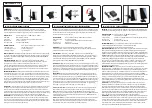
Congratulations on the purchase of your high gain wideband aerial. This aerial has been manufactured to the standard required to get
the best reception of digital terrestrial TV services (DTT). This aerial is also 4G ready - the design restricts bandwidth to prevent interference &
channel loss on your TV caused by signals from 4G transmitters. If the aerial is to be used for DTT reception check before installation at www.
dtg.org.uk/industry/coverage.html to confirm that your home is in a coverage area and to find where your local transmitter is.
For optimum results install the aerial using double screened digital coax cable and screened coax outlets.
USER GUIDE
27887D4
32 Element Digital TV Aerial
Ready
The dipole clips onto the central boom. Ensure that the cable
exit hole (from the terminal box) faces the rear of the aerial
and that the locating stud fits into the locating hole on the
boom as shown in Fig. 1.
•
Wideband – suitable for all UK TV reception areas, covering
frequency range 460-790MHz
•
Receives digital TV signals
•
Suited for moderate and strong signal strength areas
The aerial requires some assembly - please read these
instructions carefully before beginning.
1. Rotate the elements about the central fixing clip until
they ‘snap’ into an upright position as shown in Fig. 2.
2. The central boom comes in two sections using the
bracket supplied and the holes drilled in the boom
sections join these two sections as shown in Fig. 3.
rotate
elements
1. Using the reflector clamps, screw and large wing nut,
fix the reflector assemblies to the main aerial boom as
shown in Fig. 4 and 5.
2. Check that the reflector clamp tabs locate in the holes
of the reflector boom sections and that the wing nut
is tight, see Fig. 5.
3. Ensure that the reflector elements are facing towards the
front of the aerial (convex surface forward).
engage
tab
in hole
reflector
element
locating
hole
locating stud
rear of aerial
element
in upright
position
reflector boom
assembly
central boom
dipole
reflector
clamps
Main Features
A. Fitting the dipole assembly
C. Fitting the reflectors
B. Rotating aerial elements and central
boom assembly
Fig. 1
Fig. 2
Fig. 3
Fig. 4
Fig. 5




















